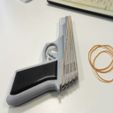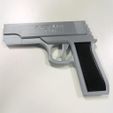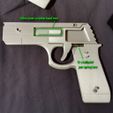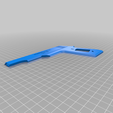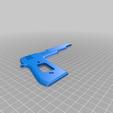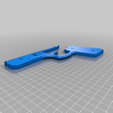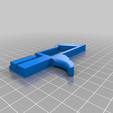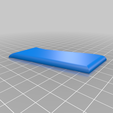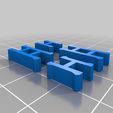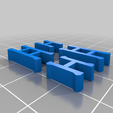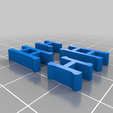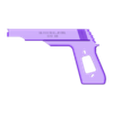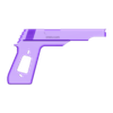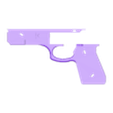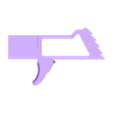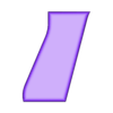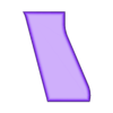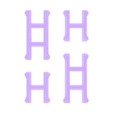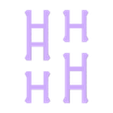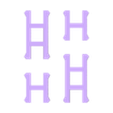The main home of this Rubber Band Gun model is on GitHub. It may have more recent updates than available here.
This is an evolution of the rubber band gun that started out as the step-up-action wooden gun by RBGuns, which was made available on Thingiverse as a laser-cut design by ddanijell (https://www.thingiverse.com/thing:848581). This was later on remixed as a 3D printable design by thecrash74 (https://www.thingiverse.com/thing:931909), and then improved by iClint (https://www.thingiverse.com/thing:1666305).
This version has the following improvements:
- 5 shot capacity instead of 3.
- Larger design suitable for number 18 rubber bands, and also better fits adult hands.
- Can use either a typical 1 inch ballpoint spring for the trigger, or a rubber band.
- Reliable mechanism with reduced risk of bands getting snagged.
- Easy printing and assembly, using clips that do not rely on perfect tolerances (no screws, glue, nor dowels).
- Some extra styling inspired by the 1911.
This is about the simplest semi-automatic rubber band gun design possible with only one moving part, which makes it both reliable and easy to set up. See it in action here.
Printing
Do not print this as one of your first 3D prints after buying a 3D printer! You must have some experience with your printer and be able to print accurately.
For this to assemble correctly, the thickness of the parts is important. It must be close to what the 3D models specify:
- the center part should be 6.0 mm thick,
- the trigger 5.6 mm,
- the sides and grips 3.0 mm.
It is OK if your printed parts deviate from these values by ±0.1 mm, but not more. If you do not have a caliper or micrometer to verify the thickness, buy one: it is pretty much an essential tool for 3D printing.
The flatter the bottom and top surfaces, the easier to assemble, and the better the assembled toy will look. Do not print on a worn-out bubbly print bed, replace the surface if necessary. To get a nice flat top surface, use enough top layers (at least 4) and a narrow extrusion width for the final layer. This is especially important for the trigger part.
‘Shorter’ and ‘longer’ variations on the clips are provided to allow assembling even if the thicknesses are not exact. Since these clips are tiny anyway, it is best to just print all variations at once and then use the ones that fit best.
Assembly
To assemble, start by pushing the two smallest clips (H shaped) into the two holes at the upper side of the middle part (the “slide”), then attach the right side by pushing it into the clips. Then insert the trigger and add either a rubber band or a 1 inch (25 mm) ballpoint pen spring (maximum outer diameter 5 mm) for tension. Then push the left side into the clips, insert the largest clips (with two connecting rods) in the grip, and finally attach the grip panels.
Should the clips not catch because your printed parts are slightly too thick, either try to sand down any irregularities, or use the ‘longer’ clips. Conversely, if the clips are too loose, try again with the ‘shorter’ clips. If none of the clip variants catch well, slightly scale up the clip models in the X direction only and try again.
If the trigger does not move smoothly, it is most likely due to roughness of the top and/or bottom surfaces. Again, the flatter your printer's bed surface, the better. A bit of sanding of the trigger piece and if necessary the side pieces, can help to remedy this.
Using
This has been tested with number 18 rubber bands (1.6mm or 1/16 inch thick and about 76 mm or 3 inches long when new). Shorter bands down to size 14 may work as well, but the trigger pull could become really hard with 5 of those loaded. From a quick comparison, it seems shorter bands hit harder at short distances, but due to their lower mass they will lose their momentum sooner and will not go farther than the longer ones.
Rubber bands must be loaded in the reverse order in which they will be launched: start at the lowest notch. Otherwise they will get tangled because the first band to be launched will be covered by others. For straight shots, maintain equal tension at the left and right sides of the rubber bands while mounting them. Do not load new bands before all the previous ones have been shot, or again there is a risk of causing a tangle.
When firing, pull the trigger all the way back to ensure correct cycling of the bands.
For maximum reliability, apply a little grease or oil to the two topmost notches of both the frame and the ‘hammer’. This will ensure the bands slide upwards quickly and makes it possible to quick-fire all 5 bands in one second.
Licensing notice
This is released under a Creative Commons - Attribution - Share Alike license. What this means if you would want to sell prints of this model, and what you should do to comply with this license, is explained on the GitHub page of this model.
If you really like this and want to send me a reward, you can find some options to tip me on my website.
Common sense reminder
Depending on how you print this, this may look like a real gun from afar. Don't do stupid things. Also do not shoot rubber bands towards living beings' eyes at close range. This design comes without any warranties or liabilities, use at your own risk.

/https://fbi.cults3d.com/uploaders/19896799/illustration-file/95d8512a-769f-4b32-b72d-43cdc47ebecf/rubbergun1-ihatethiswebsite.jpg)

